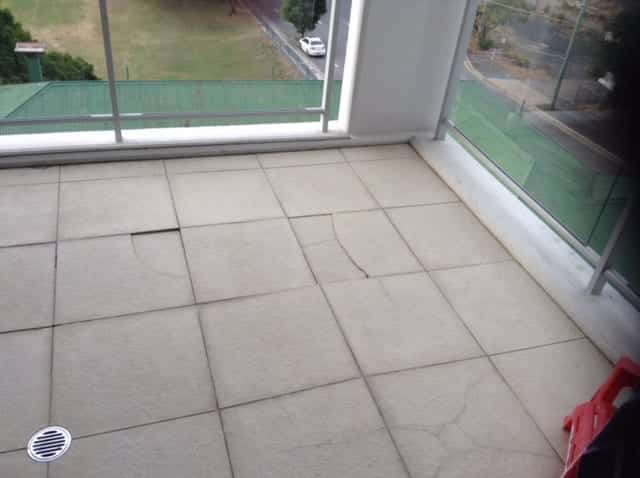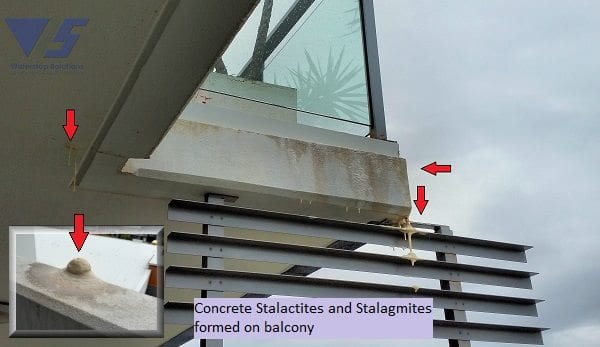
12 Jul How cyclic thermal changes can affect tiled balconies, podiums and tiled roof decks
Swinging temperatures affecting building materials
Sudden and significant thermal changes may cause stress on building materials. Tiled balconies, podiums and roof decks are especially exposed to the destructive forces of the elements such as rain, wind, sunlight and cold conditions.
All buildings go through thermal expansion and contraction with shifting temperature levels. Tiled balconies, podiums and roof decks (referred to as balconies in this document from here on) are susceptible to thermal stresses as they are constantly exposed to the elements and the sudden transition between cooler temperatures to the temperatures of a scorching summer’s day.
Tiled balconies are subject to UV and heat, causing expansion of tiles which in turn compresses the expansion joints available. The colour of the tiles plays a role because darker tiles expand more than light-coloured tiles. The same goes for highly water-absorbent permeable tiles, such as terracotta tiles.
Balconies in multi-level apartment buildings have a tendency to have minimal falls to the substrate and inadequate subfloor drainage. If you can see water pooling on the balcony and it is taking a longer time than reasonable to dry and drain away, it is most likely due to incorrect fall and /or inadequate drainage.
Correct waterproofing membrane under the tiles is essential because most membranes are not designed to hold water between the membrane and the tiles. Consequently, the choice of waterproofing product, installation and tile adhesive has a significant effect. Planter boxes and pots can add to the breakdown of the waterproofing membrane by exposure to chemicals from fertilisers, which can become concentrated as evaporation occurs.
Adequate control joints are essential to decrease the risk of the tiles moving up against each other and popping – possibly breaking the adhesive and waterproofing membrane. The joints should be installed every 3 meters and around the perimeter of the balcony. This will allow for movement during thermal changes.
Visual signs of issues:
- Excessive calcium stains (Efflorescence)
- Leaking water into the structure
- The water stains may be seen on the external walls/building facade.
- Water pooling on the balcony floor
- Drummy / Popping / Tenting / Buckled up tiles

Image: Concrete stalactites and stalagmites formed on the balcony.
Our suggested solutions for a leaking balcony repair:
Option 1
Rip up and start over again to properly address and repair the underlying problem. If the balcony membrane has deteriorated and failed, then re-grouting and surface sealing is not a permanent waterproofing solution. Ensure correct falls and subfloor drainage and select a cost-effective, long-life membrane that is capable of bridging cracks and joints.
Option 2
A budget-friendly way to addressing a leaking balcony is reducing the amount of water entering the tile bed by installing a surface sealant, such as a Penetrating Water Repellent, which is a breathable, and non-colour changing surface sealer. The Waterstop Solutions’ PWR is a clear white spirit-based penetrating waterproofing repellent that will cure with a “dry look” offering minimal to no visual change to the substrate. The system penetrates into the substrate reducing the pore size so that liquid can no longer pass through the substrate, yet still allows it to breathe. The PWR system also eases the cleaning of the area and reduces mould growth and dirt build-up, whilst protecting against salt attack and carbonation.
Option 3
Replacing the existing cementitious grouts with an epoxy grout is another alternative, however that requires re-cutting the grout and installing the epoxy-grout. The epoxy grout is not breathable. If there is considerable water trapped under the tiles after application and/or water can enter under the grouted tiles from elsewhere (i.e. a joint or pipe fitting), then water will do what water does – it will find other exit routes such as a floor to wall joint or the perimeter of the balcony. The results can be unsightly if this occurs.
Efflorescence on tiled balconies
Efflorescence usually occurs where a sand and cement bed is placed below a tiled surface. Salts and minerals that are present in the concrete can be drawn up from the tile bed through the grout by capillary action. When the carrier moisture evaporates, the salts and minerals crystallise creating a build-up of efflorescence (free lime/calcium deposits) that appears as white/light grey coloured staining on the tiles, which can have a negative impact on slip resistance.
Common reasons why efflorescence occurs may be due to the following:
- There was too much water added to the cement mix of the tile bed during the construction.
- The surface was washed down too quickly.
- It was exposed to rainfall too soon, consequently not allowing the cement to bind properly.
- The tiles were installed before the tile bed had dried properly.
- Bad batch of tile adhesive.
Tips on how to remove efflorescence stains:
- If the stains are mild: Clean with a light water blast.
- Mild to moderate stains: Clean with a fit-for-purpose cleaning agent such as CLR (Calcium, Lime & Rust Remover).
- Moderate stains: Clean with Hydrochloric acid, with caution.
- Severe stains: Mechanical removal is necessary.
If you have any issues with water ingress, cracking concrete slabs, structural cracks, concrete deterioration, deteriorated joints, moisture, seepage, efflorescence, rising damp and/or high-flow active leaks in concrete structures, we would be happy to assist you. You are welcome to contact us with any questions that you may have.
Brisbane office: (07) 3205 1899
Email: [email protected]
Sydney office: (02) 9346 8308
Email: [email protected]

